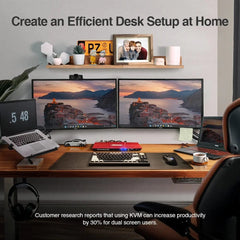What is EDID?
EDID, or Extended Display Identification Data, is a standard created by VESA (Video Electronics Standards Association) to describe their capabilities to a video source. It helps exchange important information between a source (laptops, PCs, gaming consoles, etc.) and a receiving device (monitors, TVs, projectors, etc.).
The emergence of digital displays introduced complexities in ensuring that the source device could properly configure its output to match the capabilities of the connected display, and EDID was developed to solve this problem.
By exchanging EDID data, source devices can automatically detect and adjust their output settings to ensure optimal compatibility and performance with the connected display.
What Information is Included in EDID?
The fundamental information of a display is communicated through a 128-byte data structure in EDID, which includes important details, such as manufacturer Information, display capabilities, display timing, display features, display Identification, etc. The data of the current EDID version is structured as below:

How EDID Works?
Here’s the breakdown:
- The source device communicates with the display device to check if it is powered on and ready for use.
- The display device acknowledges receipt of the signal from the source.
- The source device then requests the EDID information from the display device.
- The display device sends its EDID information back to the source device.
- After receiving the EDID information, the source device can adjust its output settings (resolution, refresh rate, color space, etc.) to match the capabilities of the display device.
In short, EDID is the ID card of a monitor. By reading the monitor's EDID, the computer can know the properties of that monitor and then make the PC output the video that best suits that monitor.
When monitor is connected to PC, there will be a conversation between them, ‘Hello, PC! I’m monitor A, I can display multiple resolutions. The max resolution I support is XXX” “Hello, monitor! I have received your information, I will output to you at the best resolution now.”

What is EDID Emulator?
An EDID emulator, on the other hand, is a device that simulates the presence of a display device and provides custom EDID information to the source device. It intercepts the communication between the source device and the actual display device and replaces the EDID data provided by the display device with its own customized EDID data.
This allows users to override or modify the EDID information reported by the display device, which can be useful for troubleshooting, compatibility testing, or configuring non-standard display setups.
In a professional audiovisual (AV) system, the EDID information exchange may occur not only between the source device and a standard display but also with intermediate components such as video walls, KVM switches, matrix, or scalers. These devices are equipped with EDID emulators or EDID management capabilities, allowing them to respond to EDID requests from source devices and provide customized or standardized EDID information as needed.
The Advantages of EDID Emulator in Practice
In terms of the ordinary KVM switches, as only one of the computers being connected to the KVM switch can be selected to connect to the display when switching the ports of the KVM, the other computers are unable to access the display’s EDID, so the computers change the display settings accordingly.
For example, if users set the window position on one computer and then switch to another computer, the window position may revert to its default position when switching back to the original computer's channel.
In TESmart's KVM switches, we add EDID emulators in each input port, so while switching the input ports, no matter the computer is currently active or not, the computer still always gets correct EDID. This keeps the display settings of the computer from being changed while switching.

TESmart KVM switch Recommendation
- TESmart 2-Port HDMI KVM Switch - HKS202-E23: This KVM switch allows you to control two computers with a single set of keyboard, mouse, and monitor. It supports HDMI video up to 4K@30Hz resolution and provides seamless switching between computers. It also features a compact design and plug-and-play functionality, making it ideal for use in home or office environments.
- TESmart 4-Port HDMI KVM Switch - HKS0802A10: This KVM switch allows you to control up to four computers with a single set of keyboard, mouse, and monitor. It supports HDMI video up to 4K@60Hz resolution and provides fast and stable switching between computers. It also features advanced EDID management, USB 2.0 hub, and hotkey switching, making it ideal for use in high-performance applications such as gaming, design, and multimedia.














